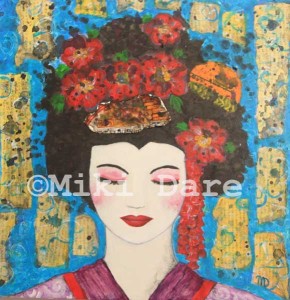
My current collection is called Geisha Girl Stereotype Survivor. I use mixed media and acrylic paint on canvas to explore my ‘mixed’ heritage. My work is about the struggle between the ‘perfect’ stereotypical images and the reality of being a woman and Asian in Canada. It’s the interface between ugly truths and the beauty of individuals who persevere. Wear garbage and graffiti with pride and creativity. Cherish the burnt canvas and torn pages of history. Be a geisha girl stereotype survivor. Below are details on the series I did within the collection.
Burnt Painted Ladies
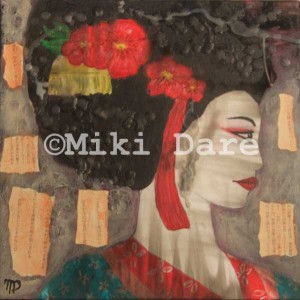
For the Burnt Painted Ladies, I set the paintings over a flame. The heat warped, darkened and bubbled the paint. Soot stains and wax drippings mar the surface. It’s representative of the destructive forces in society that over time have worn away my connection to my Japanese roots. I’m haunted by how my grandparents were interned, and yet never spoke about it. Through the injustices my grandparents lived through, and the ghosts of their lost stories — a stoic strength and scarred beauty remains in the silence.
Graffiti Geisha Girls
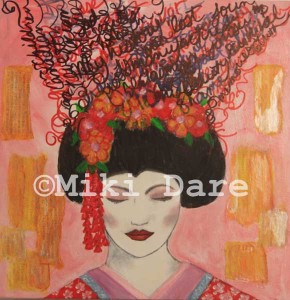
Graffiti Geisha Girls are inspired by racist words in writing or in person that I have experienced and continue to experience. Some are blatant, yet more often they are subtle. I remember in my years at UBC, reading racist graffiti in the bathrooms like “University of a Billion Chinks.” I was so disappointed that at a place of higher learning racism was still going strong. The graffiti in my paintings are my thoughts on my identity and Asian stereotypes. It’s the balance between holding your head high and yet still reeling from a racist reality that I’m told isn’t supposed to exist anymore.
Smoke Screen Sirens
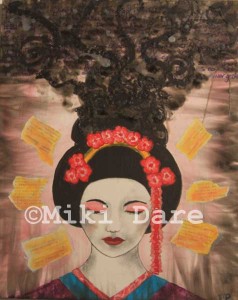
For my Smoke Screen Sirens, I explore the layers of history and how it’s covered up – both personally and as a society. I never learned about Japanese internment camps until I went to university. Where my grandparents were interned there is nothing left of the camps – no memorial on site. It’s as if the injustice of losing everything they had and being transported to Alberta to live in a shack with no running water or heat never happened. I write about internment camps on the paintings and then I cover it up with waves of soot, wax and paint. It’s uncomfortable and painful to think about their loss and what that has meant for how I see and experience the world. There’s an impulse to bury this history, by myself and society as a whole – but the truth of it never goes away.
Garbage Geisha Girls
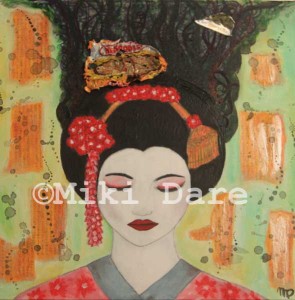
Garbage Geisha Girls are all wearing garbage in their hair, be it instant noodle packaging or an Asian drink umbrella. The subservient geisha girl is such a strong and prevalent stereotype that anyone can easily visualize this woman’s actions and behaviours– having never met a geisha in real life. How do people perceive me, once they find out about my ‘exotic’ heritage? I cannot get rid of this ubiquitous and sexualized stereotype of Japanese women, but I can stand proud and wear that garbage with style. Let the real me shine through, if only for myself.
Click here to PURCHASE PRINTS.
| All artwork and other content on this website is copyrighted by Miki Dare: all rights reserved. Reproduction of any materials contained in this website in whole or in part, in any form or medium, without express written consent, is strictly prohibited by law. For questions concerning the artwork and content on this website and/or for licensing requests for artwork use or article reprints please contact me at mikidare@hotmail.com |